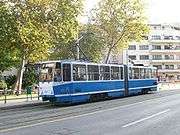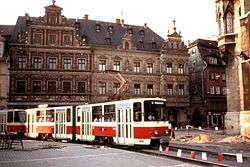Tatra KT4
| Tatra KT4 | |
|---|---|
|
KT4D in Erfurt | |
| Manufacturer | ČKD Tatra |
| Constructed | 1977–97 |
| Capacity |
26–38 (Seated) 105–168 (Standing) |
| Specifications | |
| Train length | 18,100 mm (59 ft 4 5⁄8 in) |
| Width | 2,200 mm (7 ft 2 5⁄8 in) |
| Height | 3,100 mm (10 ft 2 in) |
| Doors | 4 |
| Articulated sections | 1 |
| Maximum speed | 65 km/h (40 mph) |
| Weight | 19.9 tonnes (19.6 long tons; 21.9 short tons) |
| Traction motors | 4 x 40 kW (54 hp) |
| Electric system(s) | (?) |
| Current collection method | Pantograph |
| Bogies | 2 |
| Track gauge |
1,435 mm (4 ft 8 1⁄2 in) standard gauge, 1,000 mm (3 ft 3 3⁄8 in) metre gauge, 1,524 mm (5 ft) |
Tatra KT4 is the name of a four-axle type articulated tramcar developed by the Czech firm ČKD Tatra. The first pre-production vehicles entered service in Potsdam in 1975, with the first production vehicles in 1977. A total of 1,747 units were built, with initial deliveries to East Germany (DDR) and later to the USSR and SFR Yugoslavia. KT4 variants were built for both standard gauge and metre gauge tramways. Production of the KT4 tramcar was halted in 1991 due to worldwide economic and political changes at the time. Production was briefly resumed in 1997 to construct the last 20 units for Belgrade, Serbia.
.webm.jpg)
Since the start of the 1990s, many of the earliest production tramcars have gone through extensive refurbishment and rebuilding, including the replacement of folding doors and the installation of low-floor center sections.
History
[1] The KT4 was originally designed to demands set out by the needs of the GDR, who found bogie cars too expensive and needed a solution to their aging fleet of two-axle vehicles. The first steps into the KT4s design were made when ČKD Tatra modified a six-axle K2 tramcar, to a four-axle suspended articulation formation which later presented itself in the KT4. The KT4 has identical pedal control systems and bogies to the Tatra T3 bogie tramcar. As production continued, the design was improved, noted particularly in 1983 with the addition of thyristor control type TV3. The type is called KT4t.
Variations
Variations of the KT4 exist, though they are generally subtle and focused around seat layout and pantograph type.
- KT4D – German model
- KT4Dt – German model with TV3 thyristor
- KT4SU – Soviet Union model
- KT4YU – Yugoslavian model
KT4D
The KT4D model was delivered to the following GDR cities:
| City | Delivery years | Number delivered |
|---|---|---|
| Berlin | 1976–88 | 574 |
| Brandenburg | 1979–83 | 16 |
| Cottbus | 1978–90 | 65 |
| Erfurt | 1976–90 | 156 |
| Frankfurt (Oder) | 1987–90 | 34 |
| Gera | 1978–90 | 60 |
| Görlitz | 1987–90 | 11 |
| Gotha | 1981–82 | 6 |
| Leipzig | 1976 | 8 |
| Potsdam | 1974–87 | 45 |
| Plauen | 1976–88 | 45 |
| Zwickau | 1987–88 | 22 |
| TOTAL | 1974–90 | 1,042 |
In 1984, Leipzig handed over their eight trams to Berlin. Since the early 2000s, the Tatra tramcars in the former GDR are being replaced and sold to other countries in Central and Eastern Europe.
Original KT4D
.jpg) KT4D prototype in Potsdam
KT4D prototype in Potsdam KT4D in Berlin
KT4D in Berlin.jpg) KT4D in Brandenburg/Havel
KT4D in Brandenburg/Havel KT4D in Erfurt
KT4D in Erfurt%2C_Tatra_KT4.jpg) KT4D in Frankfurt (Oder)
KT4D in Frankfurt (Oder) KT4D in Gera
KT4D in Gera.jpg) KT4D in Gotha
KT4D in Gotha KT4D in Görlitz
KT4D in Görlitz.jpg) KT4D in Plauen
KT4D in Plauen.jpg) KT4D in Potsdam
KT4D in Potsdam at SRS Tramways
at SRS Tramways KT4D in Zwickau
KT4D in Zwickau
Modernised KT4D
 KT4Dm in Berlin
KT4Dm in Berlin- KT4Dm in Frankfurt/Oder
- KTNF6 (KT4D rebuilt with a central low-floor segment) in Cottbus
- KTNF8 (another variant with central low-floor segment added) coupled with KT4Dm in Gera
 KT4D mod 301 in Gotha 2005
KT4D mod 301 in Gotha 2005- Both actual colors of KT4D in Görlitz
 Modernised KT4D in Plauen
Modernised KT4D in Plauen- KT4Dm double in Potsdam
 KT4DC in Zwickau
KT4DC in Zwickau KT4DC in Zwickau
KT4DC in Zwickau
Sold KT4Ds
- KT4SU in Kaliningrad
- KTNF6 in Cottbus
- KT6T (KTNF6) in Tallinn
KT4SU
The Soviet Union ordered the KT4SU for their meter-gauge tramways, the following cities received deliveries:
| City | Delivery years | Number delivered |
|---|---|---|
| Yevpatoria | 1987–90 | 18 |
| Kaliningrad | 1987–90 | 30 |
| Liepāja | 1983–88 | 22 |
| Lviv | 1976–88 | 145 |
| Pyatigorsk | 1988–90 | 25 |
| Zhytomyr | 1981–88 | 20 |
| Tallinn | 1980–88 | 74 |
| Vinnytsia | 1980–90 | 81 |
| TOTAL | 1976–90 | 415 |
KT4YU
The KT4YU is the Yugoslav variant of the tramcar, which were delivered to the now Serbian and Croatian capitals. The last KT4s ever produced were delivered to Belgrade in 1997. Those tramcars were equipped with IGBT modules and recouperative braking and named KT4M-YUB (where B stands for Belgrade to be distinguished from Zagreb model). In 2002, 30 Belgrade tramcars were modernized in Goša / Inekon, and marked as KT4-YUBM.
| City | Delivery years | Number delivered |
|---|---|---|
| Belgrade | 1980–97 | 220 |
| Zagreb | 1985–86 | 51 |
| TOTAL | 1980–97 | 271 |
 Tatra KT4M-YU (1997) in Belgrade
Tatra KT4M-YU (1997) in Belgrade Tatras KT4 in Belgrade
Tatras KT4 in Belgrade.jpg) KT4-YUB in Belgrade
KT4-YUB in Belgrade KT4YUBM in Belgrade
KT4YUBM in Belgrade Tatra KT4M-YU (1997) in Belgrade
Tatra KT4M-YU (1997) in Belgrade Tatra KT4-YU in Belgrade
Tatra KT4-YU in Belgrade Tatra KT4-YU in Belgrade
Tatra KT4-YU in Belgrade.jpg) Tatra KT4M-YU (1997) in Belgrade
Tatra KT4M-YU (1997) in Belgrade KT4YUBM in Belgrade
KT4YUBM in Belgrade KT4YU in Belgrade
KT4YU in Belgrade Tatra KT4YU in Zagreb
Tatra KT4YU in Zagreb.jpg) Tatra KT4YU in Zagreb
Tatra KT4YU in Zagreb Tatra KT4YU in Zagreb
Tatra KT4YU in Zagreb
Other variations of the KT4
A series of KT4 trams were also produced for Pyongyang, North Korea, but have subsequently had their articulation removed.
See also
References
- ↑ Source: The Development of The Modern Tram, by Brian Patton
- Statistical Data, is duplicated from TatraWagen.de (In German)
External links
| Wikimedia Commons has media related to Tatra KT4. |
- (German) Ivo Köhler: KT4 – Der Kurzgelenkwagen aus Prag, Verlag GVE, Berlin 2009, ISBN 978-3-89218-104-0




